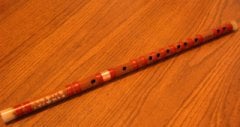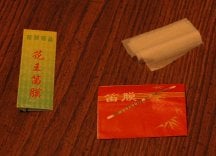Dizi
The dizi (Chinese: 笛子; pinyin: dízi), is a Chinese transverse flute. It is also sometimes known as the di (笛) or hengdi (橫笛), and has varieties including the qudi (曲笛) and bangdi (梆笛).
These names are likely to have multiple spellings, too, depending on the transliteration used to convert from Chinese names. Nonetheless, dizi seems to be the most common name (and written form) used in the West.
The dizi is a major Chinese musical instrument, and is widely used in many genres of Chinese folk music, as well as Chinese opera, and the modern Chinese orchestra. Traditionally, the dizi has also been popular among the Chinese common people, and it is simple to make and easy to carry.[1]
Most dizi are made of bamboo, which explains why dizi are sometimes known by simple names such as "Chinese bamboo flute." However, "bamboo" is perhaps more of a Chinese instrument classification like "woodwind" in the West.
Although bamboo is the common material for the dizi, it is also possible to find dizi made from other kinds of kinds of wood, or even from stone. Jade dizi (or yudi, 玉笛) are popular among both collectors interested in the almost magical beauty of jade dizi, and among professional players who seek an instrument with look that matches the quality of their renditions. But jade may not be the best material for dizi since, as with metal, jade may not be so tonally responsive, unlike bamboo which is more resonant.
The dizi is not the only bamboo flute of China, although it is certainly distinctive. Other Chinese bamboo wind instruments include the vertical end-blown xiao, the guanzi (double reed), the koudi, and the bawu (free reed).
Membrane
Whereas most simple flutes have only a blowing hole (known as chui kong in Chinese) and finger-holes, the dizi has very different additional hole, called a mo kong (膜孔), between the embouchure and finger-holes. A special membrane called dimo (笛膜, lit. "di membrane"), made from an almost tissue-like shaving of reed, is made taut and glued over this hole, traditionally with a substance called ejiao. Garlic juice or glue sticks may also be used to adhere the dimo. This application process, in which fine wrinkles are created in the centre of the dimo to create a penetrating buzzy timbre, is an art form in itself.
The dimo covered mokong has a distinctive resonating effect on the sound produced by the dizi, making it brighter and louder, and adding harmonics to give the final tone a buzzing, nasal quality. Dizi have a relatively large range, covering about two-and-a-quarter octaves.
Techniques
Dizi are often played using various "advanced" techniques, such as circular breathing, slides, popped notes, harmonics, "flying finger" trills, multiphonics, fluttertonguing, and double-tonguing. Most professional players have a set of seven dizi, each in a different key (and size). Additionally, master players and those seeking distinctive sounds such as birdsong may use extremely small or very large dizi.
Origins
There are many suggestions for the source of dizi. While some suggest that the Yellow Emperor ordered his government official to make the bamboo musical instrument, others believe that dizi was imported into China during the Han Dynasty (206 B.C.E.-220 C.E.).
Recently, archaeologists have discovered evidence suggesting that the simple transverse flutes (though without the distinctive mokong of the dizi) have been present in China for over 9,000 years. Fragments of bone flutes from this period are still playable today, and are remarkably similar to modern versions in terms of hole placement, etc, found at Jiahu site. These flutes share common features of other simple flutes from cultures all around the world, including the ney, an end-blown cane flute which was depicted in Egyptian paintings and stone carvings. In fact, recent archeological discoveries in Africa suggest that the history of such flutes may date back a very long way in human history indeed.
The first written record of the membrane (dimo) dates from the 12th century. On traditional dizi the finger-holes are spaced approximately equidistantly, which produces a temperament of mixed whole-tone and three-quarter-tone intervals. During the middle of the 20th century dizi makers began to change the finger hole placements to allow for playing in equal temperament, as demanded by new musical developments and compositions, although traditional dizi continue to be used for purposes such as kunqu accompaniment. A fully chromatic version of the dizi, called xindi.
Styles
Contemporary dizi styles based on the professional conservatory repertory are divided into two: Northern and Southern, each style having different preferences in dizi and playing techniques. In Northern China, for example, the bangdi is used to accompany Bangzi opera, with a sound that is bright and vigorous. In Southern China, the qudi accompanies Kunqu opera and is used in music such as Jiangnan Sizhu, has a more mellow, lyrical tone.
Performers
Major dizi performers of the 20th century who have contributed to dizi playing in the new conservatory professional concert repertory, often based on or adapted from regional folk styles, include Feng Zicun, Liu Guanyue, Lu Chunling and Zhao Songting.
Feng Zicun (冯子存,1904-1987) was born in Yangyuan, Hebei province. Of humble origins, Feng had established himself as a folk musician by the time of the founding of the People’s Republic of China, playing the dizi as well as the four-string fiddle sihu in local song and dance groups, folksongs and stilt dances. He also introduced errentai, the local opera of inner Mongolia, to Hebei after spending four years there as a musician in the 1920s.
In 1953, Feng was appointed to the state-supported Central Song and Dance Ensemble in Beijing as dizi soloist, and accepted a teaching post at the China Conservatory of Music (Beijing) in 1964.
Feng adapted traditional folk ensemble pieces into dizi solos, such as Xi xiang feng (Happy Reunion), Wu bangzi (Five Clappers), contributing to the new Chinese conservatory curricula in traditional instrument performance. Feng’s style, virtuosic and lively, has been known as representative of the folk musical traditions of northern China.
Liu Guanyue (刘管乐,1918- ) was born in An'guo county, Hebei. Born to a poor peasant family, Liu was a professional folk musician who had earned a meagre living playing the guanzi, suona, and dizi in rural ritual ensembles before becoming a soloist in the Tianjin Song-and-Dance Ensemble (Tianjin gewutuan) in 1952.
Liu together with Feng Zicun are said to be representatives of the Northern dizi style. His pieces, including Yin zhong niao (Birds in the Shade), He ping ge (Doves of Peace) and Gu xiang (Old Home village) have become part of the new conservatory professional concert repertory.
Lu Chunling (陆春龄,1921- ) was born in Shanghai. In pre-1949 Shanghai, Lu worked a trishaw driver, but was also an amateur musician, performing the Jiangnan sizhu folk ensemble repertory. In 1952, Lu became dizi soloist with the Shanghai folk Ensemble (Shanghai minzu yuetuan), and also at the Shanghai Opera Company (Shanghai geju yuan) from 1971 to 1976. In 1957 he taught at the Shanghai Conservatory of Music, and became Associate Professor in 1978.
Lu has performed in many countries as well as throughout China and has made many recordings. His dizi playing style has become representative of the Jiangnan dizi tradition in general. He is well known as a longtime member of the famous Jiangnan sizhu music performance quartet consisting of Zhou Hao, Zhou Hui, and Ma Shenglong. His compositions include Jinxi (Today and Yesterday).
Zhao Songting (zh:趙松庭,1924- ) was born in Dongyang county, Zhejiang. Zhao had trained as a teacher in Zhejiang, and had studied law, Chinese and Western music in Shanghai. In the 1940s he worked as a music teacher in Zhejiang, and became the dizi soloist in the Zhejiang Song and Dance Ensemble (Zhejiang Sheng Gewutuan) in 1956. He also taught at the Shanghai Conservatory of Music and the Zhejiang College of Arts (Zhejiang sheng yishu xuexiao).
Because of his midle class background, Zhao had suffered in the political campaigns of the 1950s and 1960s and was not allowed to perform, instead he taught many students who went on to become leading professional dizi players, and to refine dizi design. He has been reinstated in his former positions since 1976.
Zhao's compositions include San wu qi (Three-Five-Seven), which is based on a melody from wuju (Zhejiang traditional opera).
Notes
- ↑ This is in contrast to the xiao, a vertical bamboo flute which has historically been favored by scholars and the upper classes.
ReferencesISBN links support NWE through referral fees
- New Grove Dictionary of Music and Musicians, second edition, edited by Stanley Sadie and John Tyrrell (London, 2001).
See also
- Chinese flutes
- Traditional Chinese musical instruments
- Koudi
- Music of China
| Traditional Chinese musical instruments | ||
|---|---|---|
| █ Silk (string): Plucked: Guqin • Se • Guzheng • Konghou • Pipa • Sanxian • Ruan • Liuqin • Yueqin • Qinqin • Duxianqin █ Bowed: Huqin • Erhu • Zhonghu • Gaohu • Banhu • Jinghu • Erxian • Tiqin • Yehu • Tuhu • Jiaohu • Sihu • Sanhu • Zhuihu • Zhuiqin • Leiqin • Dihu • (Xiaodihu • Zhongdihu • Dadihu) • Gehu • Diyingehu • Laruan • Matouqin • Yazheng █ Struck: Yangqin • Zhu | ||
| █ Bamboo (woodwind): Flutes: Dizi • Xiao • Paixiao • Koudi █ Oboes: Guan • Suona █ Free-reed pipes: Bawu • Mangtong | ||
| █ Gourd (woodwind): Sheng • Yu • Lusheng • Hulusi • Hulusheng | ||
| █ Percussion: Wood: Muyu • Guban █ Stone: Bianqing █ Metal: Bianzhong • Fangxiang • Luo • Yunluo █ Clay: Xun █ Hide: Daigu • Bangu • Paigu • Tanggu | ||
| █ Others: Gudi • Lusheng • Kouxian | ||
Credits
New World Encyclopedia writers and editors rewrote and completed the Wikipedia article in accordance with New World Encyclopedia standards. This article abides by terms of the Creative Commons CC-by-sa 3.0 License (CC-by-sa), which may be used and disseminated with proper attribution. Credit is due under the terms of this license that can reference both the New World Encyclopedia contributors and the selfless volunteer contributors of the Wikimedia Foundation. To cite this article click here for a list of acceptable citing formats.The history of earlier contributions by wikipedians is accessible to researchers here:
The history of this article since it was imported to New World Encyclopedia:
Note: Some restrictions may apply to use of individual images which are separately licensed.

